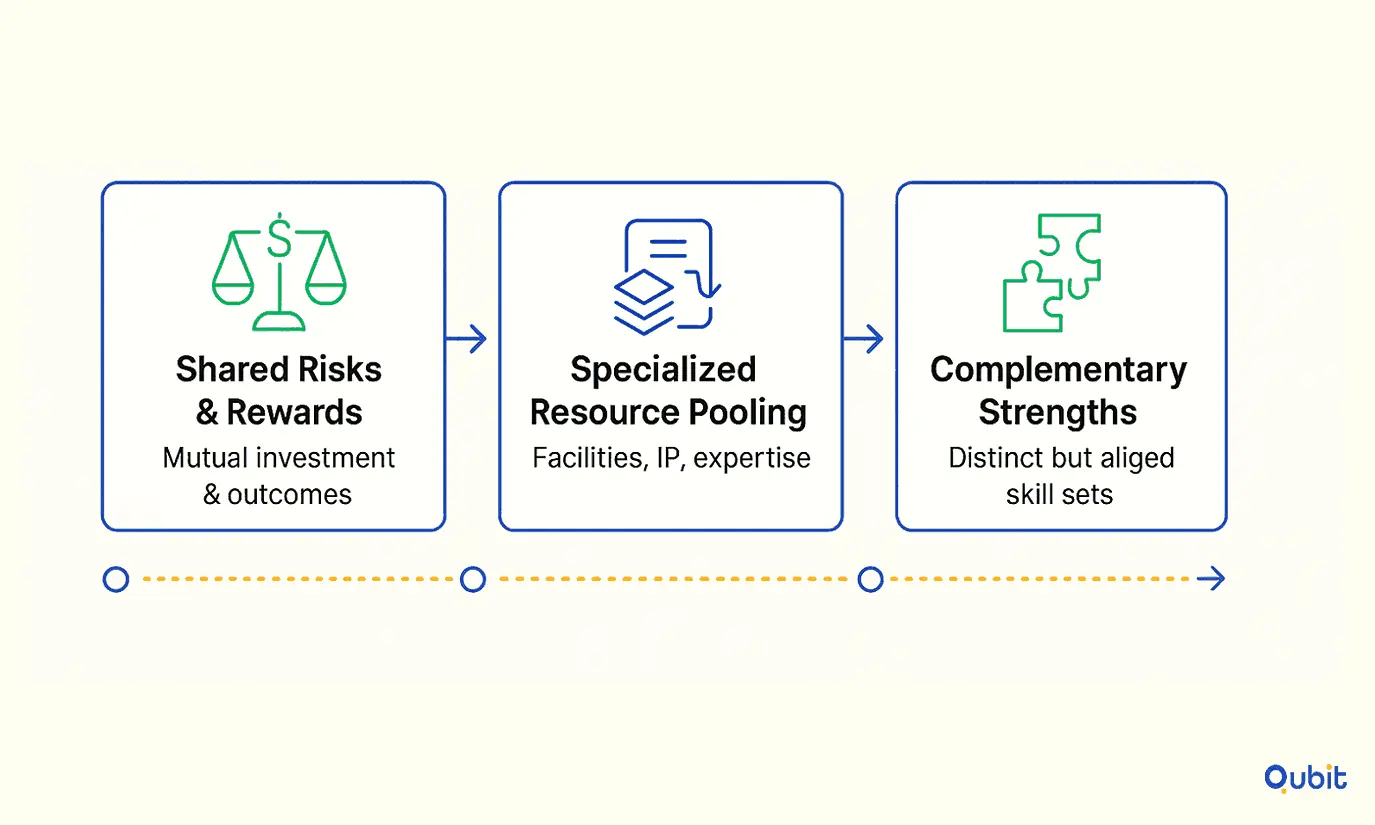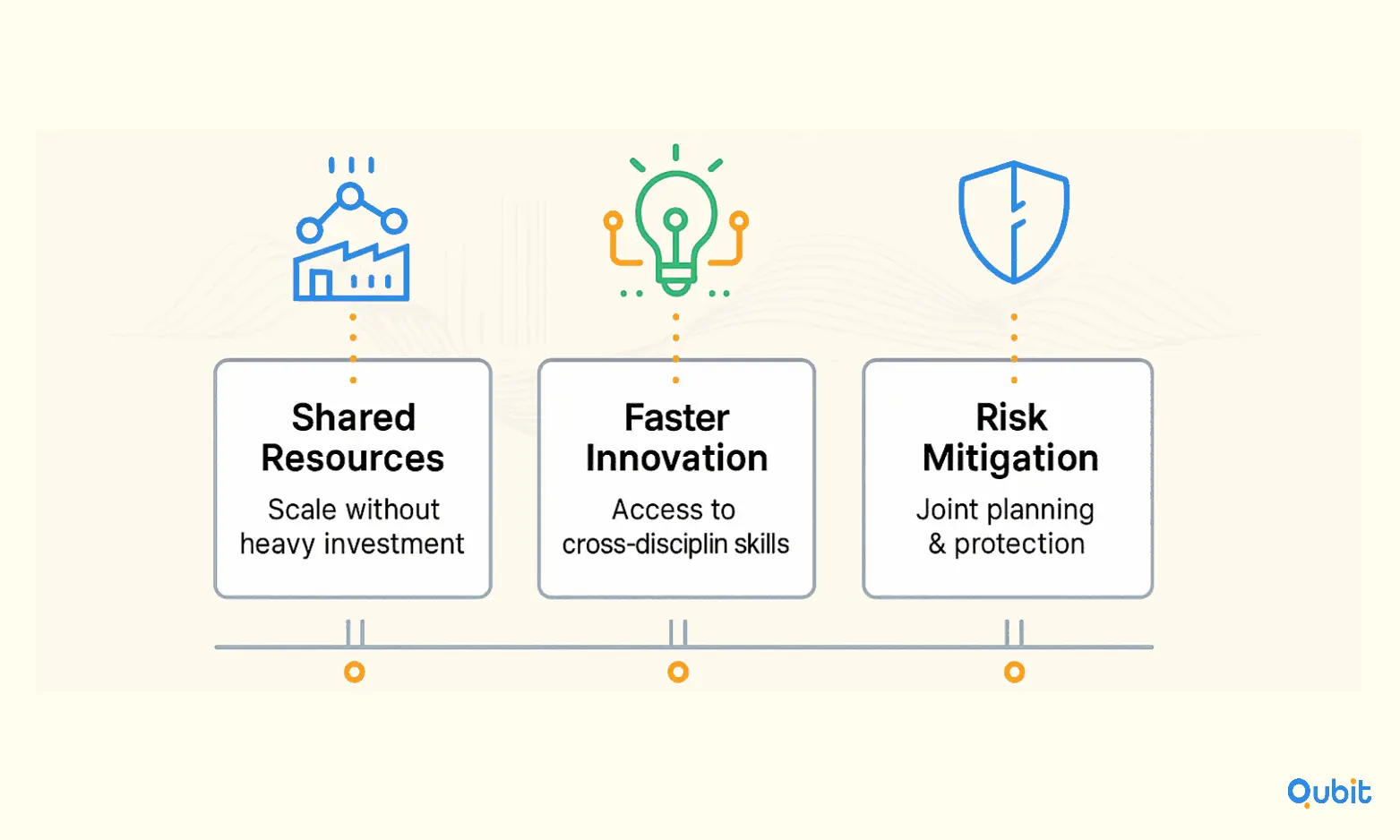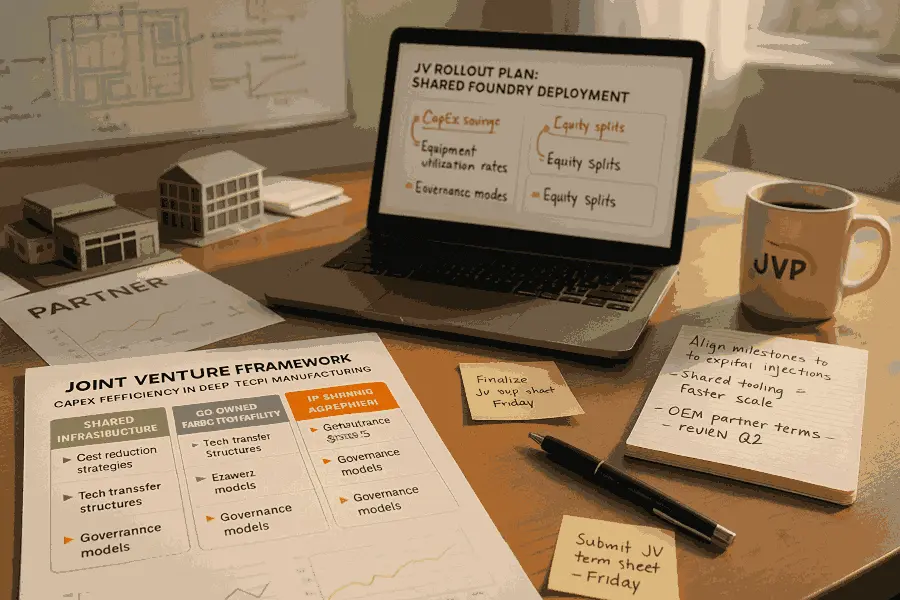The deep-tech sector is on a trajectory to surpass $714.6 billion by 2031, fueled by an impressive 48.2% compound annual growth rate (CAGR) between 2025 and 2031. This rapid expansion underscores the need for innovative funding models to address the capital-intensive nature of deep-tech manufacturing. Joint ventures have emerged as a strategic solution, enabling companies to pool resources, share risks, and reduce capital expenditures (CapEx) while accelerating technological breakthroughs.
A broader perspective emerges from insights on fundraising strategies for deep-tech startups, which frame joint ventures within a range of financial models across the sector. This article explores how joint ventures are reshaping the financial landscape of deep-tech manufacturing, covering definitions, challenges, benefits, case studies, and future trends. Let’s jump right in.
Understanding Joint Ventures in Deep-Tech Manufacturing
Joint ventures (JVs) have become a cornerstone of progress in deep-tech manufacturing, offering a collaborative framework where companies share risks, pool specialized resources, and combine complementary capabilities. These partnerships are particularly significant in industries that demand high capital expenditures (CapEx) and advanced technological expertise.

What Defines a Joint Venture in Deep-Tech?
At its core, a joint venture in deep-tech manufacturing is a strategic partnership between two or more entities. These entities work together to achieve specific goals, such as developing cutting-edge technologies or scaling production capabilities. Unlike traditional partnerships, JVs involve shared ownership, responsibilities, and financial risks, making them uniquely suited for high-stakes industries like robotics, semiconductors, and advanced materials.
Key characteristics of deep-tech JVs include:
- Shared Risks and Rewards: Both parties invest resources and expertise, sharing the financial risks and potential returns.
- Specialized Resource Pooling: Each partner contributes unique assets, such as intellectual property, manufacturing facilities, or technical know-how.
- Complementary Strengths: JVs often bring together companies with distinct but complementary capabilities, enabling them to tackle complex challenges collaboratively.
Why Are Joint Ventures Crucial in Deep-Tech Manufacturing?
The importance of joint ventures in this sector lies in their ability to reduce CapEx while accelerating innovation cycles. By combining resources, companies can minimize the financial burden of developing and scaling advanced technologies. This collaborative approach also fosters innovation by merging diverse expertise and leveraging state-of-the-art tools.
For instance, the joint venture approach complements discussions on robotics and advanced-materials startup funding, linking collaborative agreements with specialized investment strategies in these industries. This synergy ensures that both funding and operational strategies align with the unique demands of deep-tech manufacturing.
In summary, joint ventures are not just financial arrangements; they are innovation accelerators. By sharing risks, pooling resources, and combining strengths, these partnerships enable companies to push the boundaries of what’s possible in deep-tech manufacturing.
Challenges in Deep-Tech Manufacturing
Deep-tech manufacturing presents a unique set of hurdles that demand innovative solutions and strategic foresight. Among the most pressing challenges are high capital expenditures (capex), technological complexity, and market uncertainty—all of which can significantly impact scalability and profitability.
High Capital Expenditures
Deep-tech manufacturing often requires substantial upfront investments in specialized equipment, research, and infrastructure. For instance, venture investment in South Korea's deep-tech sectors reached KRW 3.6 trillion in 2024, marking a 34% year-over-year increase, with AI and bio-healthcare leading the charge. This highlights the growing financial demands in cutting-edge industries. Such capex challenges can deter smaller players or startups from entering the field, making joint ventures and strategic partnerships essential for pooling resources and mitigating risks.
Technological Complexity
The rapid pace of technological evolution in deep-tech manufacturing adds another layer of difficulty. Companies must continuously adapt to emerging innovations while maintaining operational efficiency. This dynamic environment often necessitates a balance between investing in new technologies and optimizing existing processes. A review of Series A funding benchmarks for robotics startups provides metrics that can be applied to assess joint venture contributions during early-stage funding, offering valuable insights into how startups can navigate these complexities.
Market Uncertainty
Market fluctuations further complicate the landscape, creating unpredictable demand cycles and pricing pressures. Collaborative approaches, such as joint ventures, can help manufacturers share risks and stabilize operations during volatile periods. These partnerships are particularly effective in aligning resources and expertise to address shifting market dynamics.
Deep-tech manufacturing is undeniably challenging, but strategic collaboration and a focus on innovation can help businesses overcome these obstacles and thrive in this competitive sector.
Challenges in Forming and Managing Joint Ventures
Establishing and sustaining a joint venture often presents a complex set of challenges that require careful planning and execution. Misaligned objectives and unclear governance structures frequently emerge as major obstacles, potentially derailing the partnership before it gains momentum. When partners fail to align their strategic goals, the venture risks becoming fragmented, leading to inefficiencies and disputes.
Strategic Alignment and Governance
A successful joint venture hinges on mutual understanding and clearly defined roles. Without a shared vision, partners may struggle to prioritize initiatives, undermining the venture’s long-term viability. Additionally, governance structures that lack transparency or accountability can exacerbate conflicts, making it difficult to resolve disagreements or adapt to changing market conditions.
Legal and Regulatory Complexities
Legal frameworks are another critical hurdle. Joint ventures often span multiple jurisdictions, requiring compliance with diverse regulations. Transparent agreements and rigorous due diligence are essential to mitigate risks and ensure all parties are protected. Discussions on non-dilutive funding for advanced-materials R&D highlight alternative financial options that can work in tandem with joint venture structures for manufacturing, offering a way to address financial challenges while maintaining regulatory compliance.
Cultural Differences
Cultural disparities between partners can also pose significant challenges. Differences in communication styles, decision-making processes, and organizational values may lead to misunderstandings or friction. Harmonizing these cultural elements is crucial for fostering collaboration and trust.
Financial Structuring
Finally, structuring the financial aspects of a joint venture demands meticulous planning. Disparities in investment expectations or revenue-sharing models can create tension, especially if one partner feels disadvantaged. A balanced, transparent financial structure is key to ensuring equitable contributions and rewards.
Effective management of these challenges requires a proactive approach, combining strategic alignment, legal clarity, cultural harmonization, and sound financial planning to build a resilient and successful joint venture.
Benefits and Strategies for Reducing CapEx Through Joint Ventures
Joint ventures offer a powerful approach to reducing capital expenditures (CapEx) while fostering innovation and growth. By pooling resources and expertise, businesses can unlock significant financial and operational advantages.

1. Shared Resources for Economies of Scale
Combining resources such as facilities, equipment, and personnel in a joint venture minimizes overhead costs. This shared approach allows companies to scale operations efficiently without the burden of individual investments. For example, pooling manufacturing facilities can reduce maintenance expenses and optimize production capacity. Insights into equipment financing for robotics startups offer a perspective on how external financing methods integrate with joint ventures to optimize production capabilities.
2. Accelerated Innovation Through Diverse Expertise
Joint ventures bring together diverse teams with specialized skills, enabling faster innovation and shorter time-to-market for new products. Access to advanced technologies and unique perspectives can drive breakthroughs in research and development (R&D). This collaborative environment is particularly beneficial in industries like deep tech, which has seen a surge in venture capital funding, claiming 20% in 2023, up from 10% a decade prior. Such growth highlights investor confidence in partnerships that prioritize cutting-edge advancements.
3. Risk Mitigation with Shared Contingency Planning
Risk-sharing is another critical benefit of joint ventures. By distributing financial and operational risks, companies can safeguard their investments and reduce exposure to market fluctuations. Joint contingency planning ensures that both parties are prepared for unforeseen challenges, creating a robust safety net for long-term success.
Joint ventures not only reduce CapEx but also create opportunities for sustainable growth through collaboration. Whether it’s shared resources, accelerated innovation, or risk mitigation, these partnerships pave the way for more efficient and resilient business models.
Case Studies of Successful Joint Ventures
Collaborative ventures have consistently proven their ability to reduce capital expenditure (CapEx) while driving operational success. This section explores three compelling examples from the semiconductor, renewable energy, and robotics sectors, showcasing both horizontal and vertical integration approaches.
Polaris-Zero Motorcycles Electric Powertrain Integration
The partnership between Polaris and Zero Motorcycles exemplifies a horizontal joint venture that merges vehicle design expertise with cutting-edge electric vehicle (EV) technology. Their collaboration resulted in the Ranger XP Kinetic, an electric utility vehicle that sold out within two hours of its preorder launch. This case highlights how manufacturing-focused tech transfer can accelerate product innovation and market demand.
Honda-LG Energy Battery Plant
Honda and LG Energy’s $4.4 billion joint venture in Ohio demonstrates a vertical integration model aimed at deep tech manufacturing. By establishing a battery production facility with a target for mass production by 2025, this partnership is set to create 3,000 jobs while addressing critical supply chain needs in the renewable energy sector. Such initiatives underline the importance of aligning resources for long-term scalability and sustainability.
Bosch-IPercept Predictive Maintenance
Bosch and IPercept have joined forces to develop an AI-driven predictive maintenance solution, often referred to as a "fitness tracker" for industrial machines. Following a successful pilot program, this innovation is now being expanded across production lines, significantly enhancing manufacturing efficiency. This joint venture showcases how technology partnerships can optimize operational workflows while reducing downtime.
These case studies illustrate the transformative potential of joint ventures across diverse industries, validating their role in minimizing CapEx and fostering operational excellence.
Future Trends in Joint Ventures for Deep-Tech Manufacturing
The landscape of deep-tech manufacturing is undergoing transformative changes, with joint ventures playing a pivotal role in driving innovation and efficiency. As industries evolve, several key trends are emerging that will shape the future of these collaborations.
Sustainability as a Core Driver
Eco-efficient manufacturing practices are becoming a cornerstone of joint ventures in deep-tech manufacturing. Companies are increasingly prioritizing sustainability initiatives to reduce environmental impact while optimizing costs. These efforts not only align with global regulatory demands but also enhance brand reputation and operational efficiency. For instance, partnerships are focusing on developing energy-efficient production methods and utilizing recyclable materials, ensuring long-term viability in a competitive market.
Expanding Global Partnerships
Globalization is unlocking new opportunities for joint ventures by expanding resource pools and fostering cross-border collaborations. Strategic alliances between companies from different industries are accelerating innovation, particularly in hardware-focused manufacturing ventures. These cross-industry strategic alliances combine expertise to reduce time-to-market for advanced technologies, creating a model that is becoming increasingly common in the sector.
AI-Driven Automation
Artificial intelligence is revolutionizing production processes, making them faster, smarter, and more cost-effective. Joint ventures are leveraging AI to optimize workflows, enhance quality control, and predict maintenance needs, ensuring seamless operations. This integration not only boosts productivity but also positions companies to adapt to rapidly changing market demands.
Government-Backed Funding
Targeted grants and funding programs are lowering investment risks for large-scale manufacturing expansions. These initiatives are particularly critical for ventures focused on hardware, which continues to dominate returns in deep-tech sectors. As hardware-centric startups deliver higher IRRs, joint ventures are increasingly shifting their focus toward manufacturing-centric opportunities.
By embracing sustainability, globalization, and AI-driven automation, joint ventures in deep-tech manufacturing are poised to redefine industry standards and drive unprecedented growth.
Conclusion
Reducing capital expenditures (CapEx) through joint ventures requires a blend of strategic alignment, innovative risk-sharing, and collaborative partnerships. By pooling resources and expertise, startups and manufacturers can unlock opportunities to scale efficiently while minimizing financial strain. These partnerships not only optimize cost structures but also foster innovation by combining complementary strengths.
The insights shared here are actionable steps toward achieving sustainable growth. Whether you're a startup looking to scale or a manufacturer aiming to diversify, applying these strategies can significantly impact your bottom line.
If you're ready to craft a compelling narrative for your deep-tech innovations and explore cost-saving joint ventures, we at Qubit Capital are here to help. Our Pitch Deck Creation service can transform your vision into a persuasive pitch. Get in touch today to take the next step toward impactful collaborations.
Key Takeaways
- Joint ventures effectively distribute financial risks and reduce capital expenditures in deep-tech manufacturing.
- Collaborative resource sharing and combined technical expertise accelerate innovation.
- Clear strategies, including robust governance and legal frameworks, are essential for successful partnerships.
- Real-world case studies demonstrate the tangible benefits of joint ventures.
- Future trends such as sustainability, globalization, and AI integration will continue to shape the manufacturing landscape.
Frequently asked Questions
What is joint venture funding?
Joint venture funding is a collaborative financial strategy where two or more companies combine their resources to finance a shared project. This approach allows the involved parties to distribute risks and responsibilities, making it an effective way to achieve mutual goals.


 Back
Back



